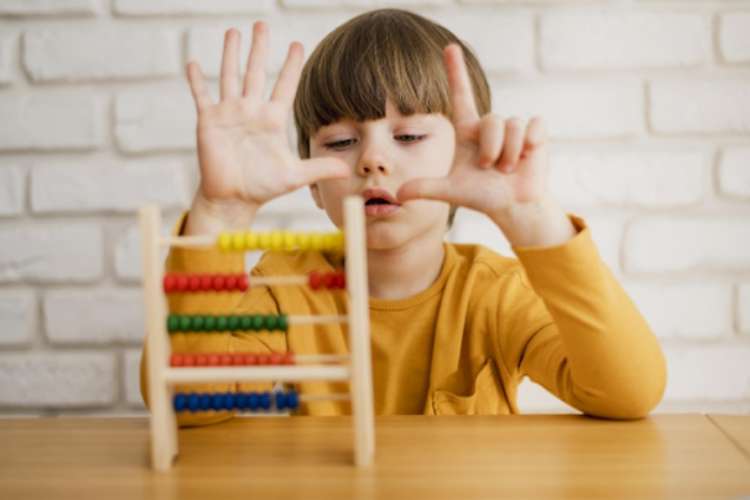Numeracy Activities for Kindergarten: Four Super-fun Games Your Kid Shouldn’t Miss Out On!


Although daunting for many children, Maths is one of the most important subjects. It has applications not only in academic studies but also for many activities which are performed in real life. It is fun as long as the foundation is strong.
Calculating tools like Abacus in mathematics bring in a structure by helping us find a pattern in the chaos. A good grip over mathematical or numeracy concepts can help strengthen our logical reasoning skills, critical thinking, problem-solving and even spatial thinking abilities.
Teaching such concepts to children can be a challenging task but one fun way to tackle the same is through numeracy activities for kindergarten kids. These nursery maths activities bring in a more fun element to the tedious and tiresome process of learning maths.
We understand how tough things can be for parents and so, here is a list of activities you can play and indulge in with your kids to skyrocket their maths skills.
Also Read: What is Children’s Social Development? A Quick Guide
Maths Activities for Kindergarten Kids
#1. The Grid Game
The game is pretty simple and it also invokes a feeling of enthusiasm and healthy competitiveness. Here, you will need at least 6 players. You can gather your kid’s friends or even the family members can play along.


Steps to Play
# You will need to make a grid on two sheets of paper
# Stick those two sheets of paper on a wall or a board on one side of the room
# Form two team, each consisting of three players. (more players can play as well)
# The two teams will now stand at the other side of the room (opposite to where sheets are stuck)
# One person from the team will run to the sheet and solve as per some stated function.
# For example, to practice subtraction, a kid would have to write zero where the fourth row and column will meet on the grid.
# The moment one person is done, he runs back to the other side and the next person in line can go towards the sheet and perform the next function.
# The team who finishes first wins the game.
Moreover, this game can also result in some exercise for the body which is always a plus point.
#2. Maths Bingo
Everyone knows the rules of this game. You call out all the numbers and someone who has all of them present on their card and crosses it first wins this game. But we have added a little twist here, instead of calling out the number straight away, you can say the equation for the same.
This game, again, can be played with kids and their friends. You can include family members as well. It offers a good way to bond and results in more family time.
Step to Play
# First, make bingo cards as per the function you wish to teach your kids. Eg: Addition.
# Give the cards to the players.
# Instead of saying a particular number, say the equation. If you wish to say the number ‘12’, then instead you can say 5+7
# When your kid figures the answer, they can check it off their card
Kids love when things are more associated with games than studies. That is why such numeracy activities are more effective than simply teaching a math function on a blackboard.
#3. This is War – Card Game
This can be a bit tricky for your little ones but once they get the hang of it, it is sure to bring in a lot of fun. This maths game can really sharpen their mind and improve the speed at which they solve problems.
Steps to Play
# Get a deck of card
# Assign a value to the face value of a card. For example – King can be 5, Queen can be 10, Ace can be 3, etc.
# Shuffle and give out cards to the children
# One person is required here to name a function to be performed for the same. Example – Addition, subtraction, multiplication, division.
# Keep the function level as per the grade the child is studying in
# After calculating, the one who has the highest number wins the game.
#4. Ludo
One of the most prominent game, this is here from the Mughal times. It was previously known as Chaupar or Pachisi. The game was modified in 1896 to include a dice and was later called Ludo.
Since the kids are young, you can first start with the snake and ladder side. The strategy to play remains the same but we have added a little twist here too. One person is required to call out a function (addition, subtraction, etc) to be performed when the dice is rolled. If you are running out of people, you can even create chits that state the function.
After rolling the dice, the person playing will have to select a chit and play accordingly.
This kind of twist takes the predictable element of ‘who will win’ away from the game and brings in a more exciting appeal.
Here, your children will learn how to read the dice, how many spaces to move ahead or behind to follow what the dice says. Such methods will help them understand the physical world around them. One of the benefits of this game for kids is that it can stimulate the areas of the brains that can help process complex thoughts.
Real School Of Montessori to the Rescue
We get it, kids can be hard to deal with but not when you have Real School Of Montessori by your side. How do we work? We believe in using smart technologies to the best of their ability to make the sessions more interactive, engaging and fun. We trust that providing a more immersive experience as opposed to the regular mundane curriculum can bring in more fruitful results.
Experience “Real” learning with our best-in-class mentors and programs that focus on education which is multi-disciplinary and futuristic.
Want to test the waters? Click here to find all our programs!
Recent Posts
What are the Advantages of Online Teaching at The Real School?
In the article -"What are the Advantages of Online Teaching at The Real School?" we…
What is the Full Form of School?: Unveiling the Acronym
The term "school" carries profound significance in the realm of education, representing more than just…
What is Math Full Form?: Cracking the Code
Mathematics, often referred to as "Math," is a subject that elicits various reactions from students…
What is Full Form of Homework?: Decoding Academics
Homework, an integral part of the academic journey, often raises questions about its purpose and…
What is Full Form of Teacher?: Demystifying Education
In the intricate tapestry of education, teachers stand as the pillars shaping the intellectual and…
What is Real Education?: Discovering Its Essence and Impact
The concept of real education is evolving, transcending traditional views that equate it solely with…


